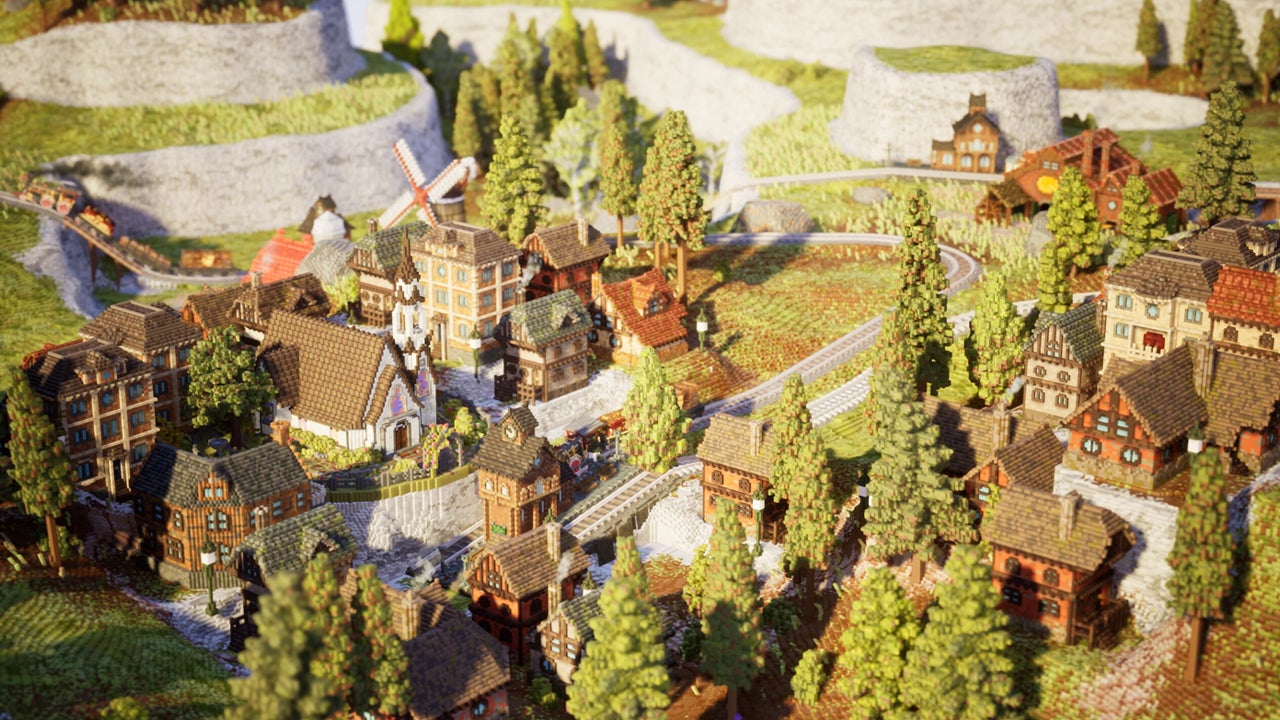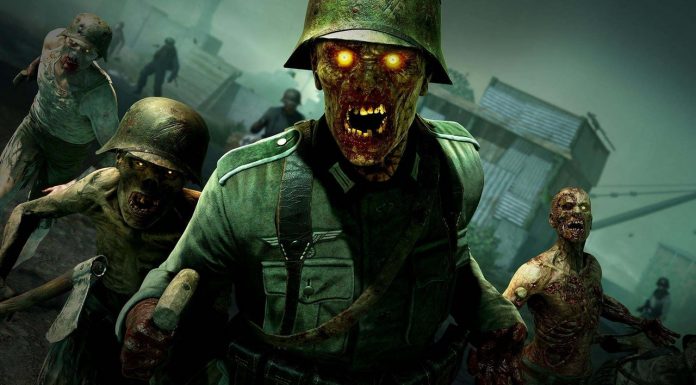
When I first pulled into Station to Station’s voxel-powered railways, I was expecting more of a straight-forward train sim, something akin to the A-Train franchise with a bit of city building. The reality, however, is much different – Station to Station is more like a puzzle game built around some of the tropes of simulation-style games, with stuff like resource and money management unlocking the next possibility in the gameplay loop. It’s disarmingly simple to explain: some of the buildings on your map are industries that produce resources. Connect those to the other buildings that need those resources. Connect them all to the cities. Profit.
When everything is connected according to its needs and its ability to produce, you win. That’s the game at its most basic. In other words, figure out how to connect everything that needs to be connected and you win. While it may not chug quite so deep into the nitty gritty of rail management, I found myself in love with its clever levels and gorgeous style nonetheless. If anything, the fact it’s not what I expected added a layer of unexpected delight to my playthrough. That being said, even if I knew going into Station to Station exactly what is was about, it’s just so charming and interesting I would still really enjoy it. The graphics, the pace, the atmosphere, the challenge, it just really appeals to me at the deepest levels of my gamer-being.
Station to Station bills itself as a “relaxing and minimalist game about building railway connections,” and I couldn’t have said it better myself. There are six different “worlds,” for lack of a better term, each split into five or six different levels.
The levels themselves vary in size, but they all take thematically from the world in which they’re placed. For example, the “Sunforge Sands” and “Golden Dunes” worlds have you laying tracks in a desert biome, while Eveningstar Valley and Greendale are voxel-infused nods to the American west. These different themes don’t really have much bearing on the puzzles themselves (other than a few bonus tasks I’ll get to later). I would have liked to have seen some more environmental differences between the worlds, ones that have a real bearing on the strategy involved in solving each level. It seems like a bit of a lost opportunity. There are a few elements that matter in different biomes, like forests that you need to pay to remove in some levels and variation in cliff heights you need to take into account in others, but I would have liked to have seen even more.
Voxel Urbana
Station to Station’s worlds are built using some of the most beautiful voxel art I’ve seen since 3D Dot Game Heroes on PS3 (which I only mention because that game rules). The amazing 3D pixelated look is present in every part of the worlds, down to circling birds and wandering horses and dromedaries. These chunky little fellas are charming enough, but each city, town, and industry also get their own voxelated models that are pretty enough to make me wish my ashes could be spread inside the worlds of Station to Station when I die. Please, someone figure that out for me.
The heart-warming voxel models are wonderful in and of themselves, but the lighting in Station to Station takes the charm up even further. The rivers and lakes glisten in the sun, and there’s a perpetual golden hour warmth to many of the levels. As you build out your tracks and link things together, the landscape begins to fill with color, with each connected industry spreading a golden ring of life from its place on the map. It’s just so lovely. Each level is still beautiful even when none of the resources have been connected yet, but as you fill out the map it turns into an inviting, colorful world that seems to be wholly unconcerned with whether or not you’re watching it. The trains move along their tracks and make their stops, the birds fly in the sky, and the other aforementioned animals wander about peacefully. I’d almost be content just floating around the map, zooming in and out to gaze at the architecture of the tiny buildings or watch a seagull make lazy figure-eights above it all even without the interesting rail management game that’s layered on top of these little worlds.
Rail Play
I could gush about the look of Station to Station for pretty much the rest of this review, but only because it fits so damn perfectly with the style of gameplay behind it. Its puzzle-like stages feel almost like a board game brought to life by some kind wizard. The concept is pretty simple: you start each level with a few buildings on your map, and then connect them together so each resource connects with the building or city that needs it. For example, in the second level in the Golden Dunes drops you into a map with a paper mill, a logging camp, and some water towers. The paper mill requires logs and water to make paper, so you’re going to need to link those buildings together by adding a train station at each and then connecting those stations with a railway. The city itself needs water (among other things), so running a track from that line of interconnected stations will deliver the hydration the growing city needs.
You’re encouraged to link up your resources in non-logical ways with a “stacking” mechanic, which is a cool little twist that had me thinking outside the box…car. In a nutshell, if your city needs tools, you’d make the connections almost in reverse order. Tools require a tool factory, which requires steel, which requires both coal and iron ore. Hook the coal and ore to the tool factory, hook the steel mill to the city, then run a freight line to the city and watch the bonuses stack up. Resources flow from one step in the process to the other and then the money flows into your coffers. It’s almost as satisfying as winning the jackpot at a casino and watching chips come rushing out – and while that level of optimization isn’t required, it’s fun to try and hit Station to Station’s cash-based bonus goal at the end of each level.
Completing a level flush with cash isn’t the only bonus goal, either. Each map has a Star goal to try your hand at, like completing a level with a stack worth $1200, for example. The main “story,” I guess you could call it, took me around eight hours to complete, but now I’ve turned my attention to replaying the levels more carefully in order to hit those bonus goals. I don’t know if there’s something special for completing them beyond a few additional achievements, but just going back and replaying the levels for the fun of those extra challenges is more than enough incentive for me.
Station to Station won’t have you banging your head against a wall with its difficulty, but it does do an excellent job balancing the need to plan ahead with the need to think on your feet. You don’t immediately start each level with each building in place: those open up only after you’ve hit a certain monetary goal that’s different for every stage. So you might plan the perfect rail line from one resource to another and back to your city, only to discover that you now have to go over an existing rail line with a more expensive bridge to link up two newly unlocked map features. More than once I got near the end of a level and had to restart because I’d run out of money to build new rail lines – and yet those unexpected failures never actually frustrated me. In fact, I felt a little sense of excitement when that would happen because it meant I got to play through the charming level again, only with the added benefit of hindsight.
Station to Station also has a light card system that offers one-time boons to use, although the order you draw them doesn’t seem to be randomized. You earn cards in the same way new buildings unlock, through the acquisition of money, and play them before finalizing a new railway. They can be things like “Cheap Rails,” which reduces the cost of the new rails, or “Heavy Freight” trains that will earn 50% more money on the given route. The Heavy Freight modifier is awesome when you have a huge stack of resources available, adding even more to that casino-like payout system. I really like this added layer of options, as they required me to make choices about when and where to spend my cards to maximize their benefits in addition to carefully laying out the railways between cities and resources. It’s so simple in execution, but it gives a nice extra layer I appreciate.
There’s even a “custom game” option right off the rip that makes Station to Station essentially endlessly replayable. Pick your level size, biome, cliff heights, industries, and difficulty and then off you go. You can even randomize the biome and industry selections, making every new game, well… an entirely new game, which I love. I’m personally a fan of the largest possible map size, because it ups the challenge quite a bit but also leads to some incredible opportunities for huge stacks. I feel like the custom maps can be even more fun than the prebuilt levels because there’s an element of chaos if you randomize the industries and biomes.























